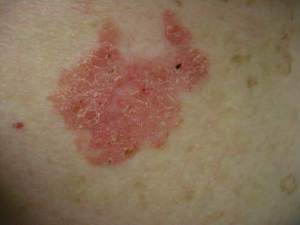What causes Bowen’s Disease to develop?
Bowen’s Disease tends to develop in fair-skinned people and is caused by over-exposure to sunlight (ultraviolet light). They are especially common in people that have lived abroad, worked outdoors, or in those that enjoy sunbathing. Ultraviolet light damages the outer layer of the skin causing cells to overgrow and this produces the small red scaly lesions. Ultraviolet light is also responsible for producing premature ageing, wrinkles, flat brown pigmented skin lesions (“sun spots”), and skin cancers. Exposure to the chemical arsenic may also produce Bowen’s Disease. Many children were given a tonic called Parisher’s Food in the 1930’s-1950’s.
Are patches of Bowen’s harmful?
Small Bowen’s are generally not very harmful and can be left untreated if they are not causing any symptoms. However, patients should be aware that there is a small risk of skin cancer development in a Bowens lesion, the risk is thought to be around 1 in 200 per year. Should this occur the change is usually obvious with a lump or ulcer developing within the patch. Patients are also at slightly higher risk of skin cancer development elsewhere because Bowen’s disease is an indicator of sun damage.
Is treatment necessary?
Patches of Bowen’s do not generally go away by themselves but can remain unchanged for many years. However, treatment is only necessary if they cause distressing symptoms or cosmetic embarrassment.
What treatments are effective?
Patients are encouraged to apply a simple moisturiser containing a sunblock (SPF 15 or above). Persistent lesions may require treatment, and these are some of the commonly used:
Efudix Cream® (5-Flourauracil Cream): Efudix® is applied twice daily for 3 weeks or once daily for 6 weeks to a small area of affected skin (typically less than 8-10 cm2 ). It works by destroying abnormal skin cells and causes a pronounced inflammation in skin lesions. It is normal to see redness, crusting, and rarely ulceration. All patients should see this skin reaction; it is part of the treatment. Treatment may need to be stopped for a few days if the reaction is very intense. You may need to ask your doctor to prescribe a topical steroid/antibiotic (Fucibet® cream) if the reaction is severe. It is 85% effective and is very effective for multiple unstable lesions. Treatment courses can be repeated or rotated if you are treating several patches.
Cryotherapy Freezing (Liquid Nitrogen): Cryotherapy destroys the unstable skin cells allowing healthy skin cells to heal the treated area. Freezing typically takes a few seconds and wounds heal in 7-15 days. Be aware that wounds on the legs take longer time to heal. It is relatively painful but very effective (90% of skin lesions will resolve with a single freeze). Side-effects include blistering, crusting and occasionally a white permanent scar.
Photodynamic Therapy (Metvix PDT®): Extensive patches on the face or elsewhere on the body may require treatment with a special cream and red light. The cream is selectively absorbed by abnormal skin cells to make a photosensitive chemical that is then destroyed by red light. PDT can be used for extensive disease and has the advantage that healing only takes 7-10 days with good cosmesis. Multiple treatments may be required, and each session is typically 70-75% effective.
Skin Curettage & Cautery: Thickened/crusty or suspicious looking patches may be better treated and removed by scraping (curettage and cautery). A local anaesthetic injection is required prior to treatment. Usually, the sample would be sent for histological analysis (biopsy) to rule out the development of squamous cell cancer. Healing typically takes 10-21 days but may be longer on the lower leg. The skin will heal with a small pink/white scar.
Do I need to be seen regularly by a dermatologist?
You don’t necessarily need to have a regular review for Bowen’s disease. However, for patients with many patches, especially if they have had a skin cancer previously we would recommend you come to see one of our Consultant Dermatologists once or twice a year for a general skin review. Unfortunately, due to current constrains, routine skin checks are not offered in NHS Dermatology clinics.
Can I do anything to help the skin problem?
Studies have shown that avoidance of further exposure to sunlight reduces the number of new skin lesions. It is advisable to avoid sun exposure by covering up with light clothing, use of a hat, and by wearing a high Sun Protection Factor (SPF>25) sunscreen.

